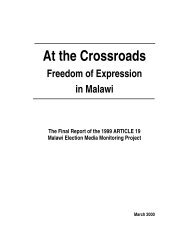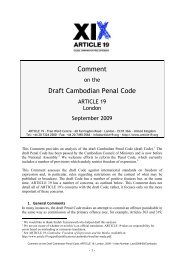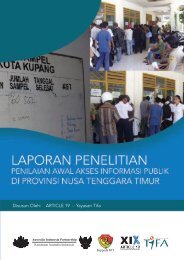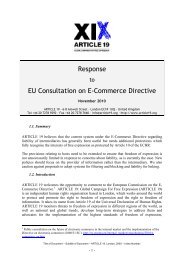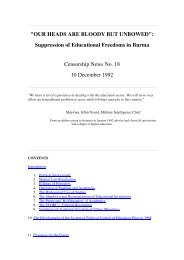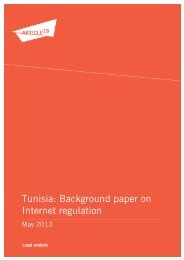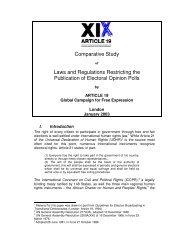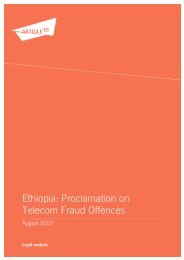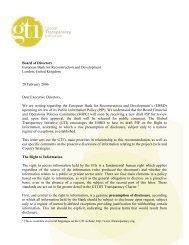FOR INTERNAL USE ONLY - Article 19
FOR INTERNAL USE ONLY - Article 19
FOR INTERNAL USE ONLY - Article 19
- No tags were found...
Create successful ePaper yourself
Turn your PDF publications into a flip-book with our unique Google optimized e-Paper software.
ARTICLE <strong>19</strong>GLOBAL CAMPAIGN <strong>FOR</strong> FREE EXPRESSIONa person’s health or safety could be categorised as ‘environmental information’. Only 30% knew thatthe obligations of the local administration included not only gathering and holding information, butalso disseminating it. Only 10% knew that the person requesting the information is not obliged toprovide the reasons for the request. No respondent knew what information should be proactivelydisseminated by the authorities according to the Aarhus Convention.When asked about public participation, nearly all officials saw the public as having a passiverole. They mostly felt that the public should only be involved at the initial stage of decision-making,and only 20% thought that the public should receive information about final decisions. In addition,30% stated that the public should not be involved in decision-making, as only specialists shouldparticipate in this process, and 10% saw public participation as dangerous, noting that the public caneasily negatively affect the work of public officials and very rarely makes a positive contribution.9,&,3 !% The current legislation does not require public bodies to produce and proactively publish many typesof information. But even for those types of information where this is required, there are problems withthe delivery of information. Decisions and orders – such as the Verkhovna Rada’s decision ‘OnInforming the Public on Environmental Issues’, and the MEP Order ‘On the Approval of theProcedure for Providing Environmental Information’ – are implemented only sporadically. Moreover,although the MEP is responsible for the publication of an annual National State of the EnvironmentReport, 229 the last such report was placed on the Internet in 2004; by January 2008 the 2005 report hadstill not appeared. 230 The long delays in producing these reports mean that the information contained inthem is usually outdated by the time it is published. 231 The State report draws on reports produced bythe Regional State Departments of the Environment (regional branches of the MEP). These tend to beproduced more regularly. For example, the Lviv regional report for 2006 was available electronicallyin mid-2007. 232 A special environmental report was published for the fifth Ministerial ‘Environmentfor Europe’ Conference, which was hosted by Ukraine in Kyiv in 2003. However, it presented anoverly positive picture of the environmental situation and the authorities’ actions. 233The Civil Defence Institute 234 produces an annual report about pollution levels and otherinformation, such as public awareness materials and leaflets. These cover issues such as information229 <strong>Article</strong> 25 of the Law on Environmental Protection.230 Interview with Serhiy Varlamov, see note 209231 Interview with Oleg Listopad, see note 82.232 Interview with Serhiy Varlamov, see note 209.233 Interview with Oleg Listopad, see note 82.234 See note 60.For Internal Use Only. Is Post-Chornobyl Ukraine Ready for Access to Environmental Information?ARTICLE <strong>19</strong>, London, 2007&)



